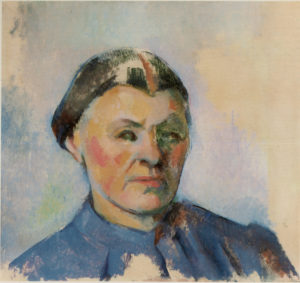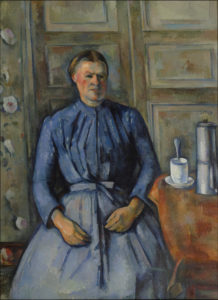R780 – Étude pour La Femme à la cafetière, vers 1895 (FWN513)
R781 – Femme à la cafetière, vers 1895 (FWN514)
Pavel Machotka
(Cliquer sur l’image pour l’agrandir)
Cézanne set himself a ambitious task in a portrait in which the setting was, paradoxically, humble and the sitter plain: La Femme à la cafetière. Fry thought that the pose was in fact natural to the sitter, since she was a servant[1], and he may well be right; but if this implies that the pose was the origin of the composition, then it puts the onus of explaining the painting on the sitter rather than on Cézanne’s alertness to the complex relationships that make a composition—even in a more homely setting. Setting up the pose probably involved work comparable to setting up a still life: moving her in front of different walls, putting this or that object next to her, choosing the right tablecloth. Of one element of this preparation we may be sure: anticipating doing a large canvas, Cézanne might first do a study of the head. There is such a study (Etude pour la femme à la cafetière, R780), and it shows us in what way it was useful; it pointed out to Cézanne that in order to fit the head into the painting’s simple shapes (which include the oval of the arms), he had to simplify and enlarge her very small jaw.

Etude pour la femme à la cafetière
vers 1895
R780 – FWN513
We therefore know the painting to be a portrait, and if the face should be the first thing we look at, we would see that it is a magnificently concentrated distillation of all the colors of the painting (with the addition of a few spots of red). The painting is in fact carefully elaborated everywhere; the least panel on the door and the smallest flower in the decorative panel on the left all matter as much as the face, and it becomes clear that the portrait is an ambitious, formal, fully realized, painting. It is unapologetically frontal, with the woman’s dress divided symmetrically by a straight midline, and it is organized with the utmost simplicity: the midline runs parallel to the doors, the spoon, and the coffee pot. But it is far from a still painting. The pull to the left of all the slanted verticals, and the woman’s left-of-center position, are balanced by her gaze to the right of center and by the coffee implements; and there is a compressed knot of energy in the center, where the pleats of the dress parallel the shape of the arms and seem to expand outward against a resistance.
[1] Fry, p. 63.
Source: Machotka, Cézanne: the Eye and the Mind.



Vous devez être connecté pour poster un commentaire.